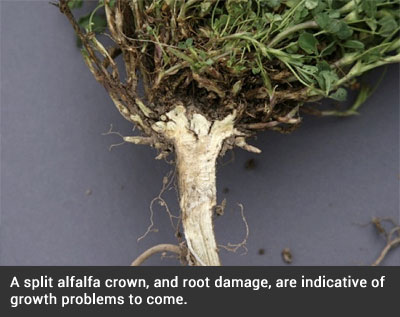
If enough heat units have accumulated where you farm, it’s time to consider evaluating alfalfa stands. In your assessment of stand quality after a brutal winter, you should specifically consider these appraisal factors.
Frost Heaving – Frost heaving is elevation of the alfalfa crown above the soil surface. This occurs when frequent freezing and thawing of soils cause soil expansion and contraction that squeezes the alfalfa taproot, forcing it upward in the soil. This will often result in breakage of lateral roots. This type of damage is especially common on fine textured, water saturated soils. In some seasons, alternate wetting and drying of clay soils is sufficient to squeeze alfalfa plants from the ground.
Note: Alfalfa cannot tolerate much heaving. Life expectancy of individual heaved plants is relative to the amount of heaving but all heaved plants will eventually be lost to the stand.
Asymmetrical growth – Buds for spring growth were formed last fall. If parts of an alfalfa root have been killed, only the living portion of the crown will give rise to new shoots. Examine alfalfa plants in several areas of fields to assess alfalfa regrowth.
Note: It may be necessary to dig representative alfalfa plants to get a good look at the evenness of bud production and regrowth.
Uneven greenup and growth – If some buds on the crown have been injured while others have not, the uninjured buds will start growth early while the killed buds must be replaced with new buds before growth can begin.
Note: Dig a few representative plants, wash them off, and examine new growth and root health. If dead buds or shoots arise from necrotic or unhealthy-looking tissue, these buds will likely not regenerate.
Root damage – Plants should be dug up 4 to 6 inches deep and then split lengthwise with a knife. Winter killed roots will have a gray, water-soaked appearance just after the soil thaws. Once water leaves the root the tissue will turn brown, dehydrated and stringy. If the root is soft and water can easily be squeezed from it, or is brown, stringy and dehydrated it is most likely winter killed. Also, if 50% or more of the rot is blackened from root rot, the plant will most likely die during spring green up or later in the year. A healthy root should be firm and white with little evidence of root rot.
Note: Roots that feature some healthy, white tissue may survive for a time but root necrosis is generally progressive and does not improve over time. If numerous alfalfa roots show obvious damage, it’s time to plan to replace the stand.